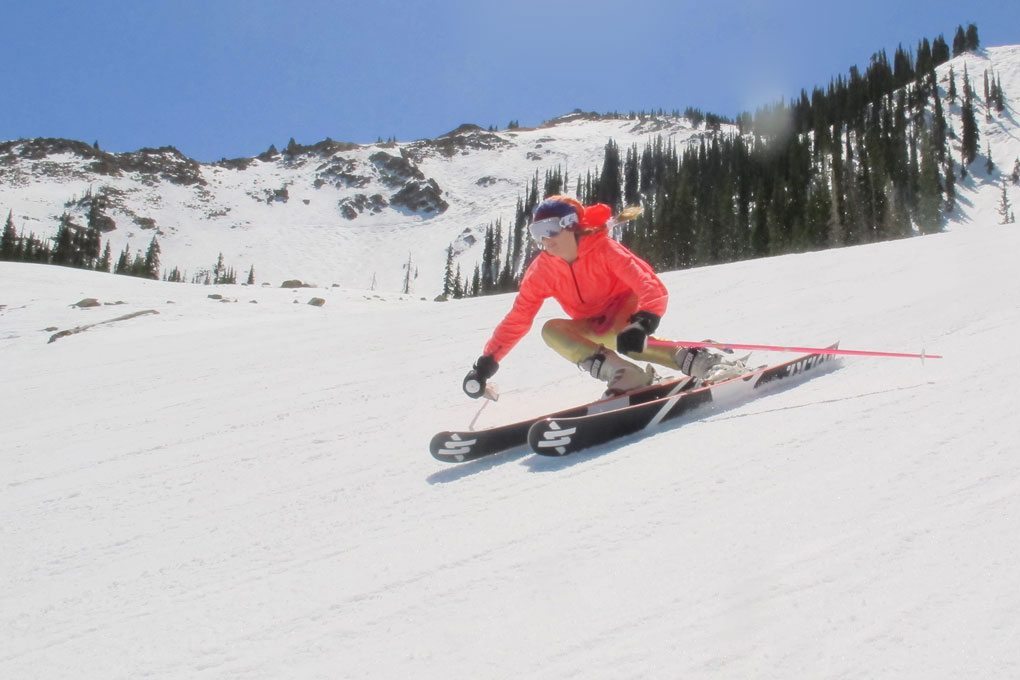This spring break, I arrived in Utah just in time to catch another awesome storm. I reached for the Shiro just as Alta reported a 20” storm total. I had just as much fun in the powder in the Keyhole area as I did in Niseko, but I also was able to ski in some soft, deep chop. Here, I felt the Shiro also did well, with enough stability to continue skiing fast. Occasionally, where the snow was firmer, I felt the large shovels flap a bit, but this wasn’t enough of a problem to knock me off balance or really slow me down.
I wasn’t able to take the Shiro through any hard, chopped-up snow, though Andrew did comment on their performance there. Mainly, he said that the skis felt squirrely and unstable in variable conditions at faster speeds. I never really found this to be a problem, but the 183cm Shiro is also more appropriate for my size. As a smaller and lighter skier than Andrew who found the length to be completely manageable, I am sure he would have benefited from a longer ski.
Though I can’t say I was all that surprised about the Shiro’s powder performance given its intended purpose, I was blown away at how well it could ski groomers. They were actually a blast—which is pretty incredible considering the Shiro is a fully (and heavily) rockered, fat powder ski.
Over the past few weeks, the typical late spring storms have been few and far between, and I have been able to reacquaint myself fully with the art of skiing groomers all day. In early April, for example, the Colorado College Freeride Club organizes a weekend popularly known as “Winterfest,” that nearly a quarter of the school attends. There are plenty of shenanigans, neon costumes, and out-of-control skiers involved, which make for a pretty outrageous weekend.

I honestly wasn’t expecting to want to ski all day, instead planning some time to lounge with friends in the sun. But Saturday and Sunday I skied pretty much non-stop from 10-4, lapping the same two runs—on the Shiro. Every run I was cruising full speed, airing all the ledges, and carving every turn. It took a slightly wider stance to initiate a carve, but once I found this point, I could really lay the ski over.
The Shiro had a poppy response, so I felt I could dig into each turn and work the ski. Even on the icier sections I felt confident with the ski on edge. Of course, there are other skis I would prefer on this sort of day (namely my GS skis, but also the Nordica La Niña, which has a little camber underfoot) but I had few complaints with the Shiro. The only issue I noticed was a little of the tip flap at high speeds.
In powder and on groomers, I really appreciated having the 183cm length. The only times I really felt overwhelmed by the ski, though, were in moguls and bumped up tree skiing. After several runs of hardpacked, tight bump turns, I felt totally worked and a little frustrated when skiing at slower speeds. In softer, larger moguls where it was easier to carry my speed down the fall line, I didn’t feel like the Shiro was too much ski.
While I had fun on most of the days I spent on the Shiro across a range of conditions, I would still be hesitant to have the Shiro as my only ski. In terms of adding a powder ski to a quiver, I think it would make a great choice, and it certainly can still be fun on non-powder days, too.
To bring it back to the Kiku, though, the Shiro and Kiku serve quite different purposes. The Kiku functions as a great all-mountain ski that does well in powder. If you are looking for a larger ski to tackle deeper snow and bigger lines, however, the Shiro could be the way to go, and keep in mind that the Shiro is offered in a 173cm length, too.
For advanced-to-expert women who are looking for a solid and fun big-mountain pow ski, the Shiro is unlikely to disappoint.
